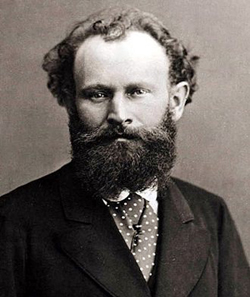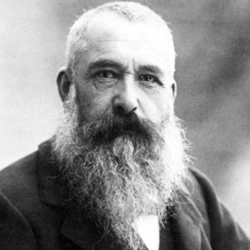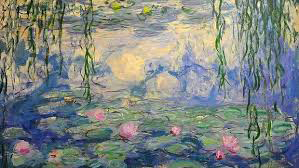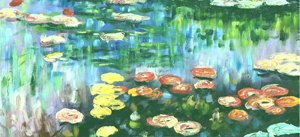MANET - MONET
 Many people confuse Manet and Monet and think they are they same man (but for one letter.) But they are two men - Edouard Manet and Claude Monet. Bearded and brown-haired, in young photos they are difficult to tell apart. The two were contemporaries in the Paris Art Scene during the birth of Impressionism. Manet was the older, more experienced of the two and never joined or considered himself an Impressionist. He didn't like being included in any group. His early masterworks created controversy in the artistic community and served as rallying factors for the young painters that would create Impressionism. Although many people may not recognize his name, it is likely they will recognize some of his paintings. Prior to what is considered "Modern Art," artists painted predominantly religious, historical, or mythological motifs. Manet was one of the first 19th century artists to paint modern-life subjects. He chose everyday subjects like beggars or people at cafes and bullfights. His work bridged the gap between Realism and Impressionism.
Many people confuse Manet and Monet and think they are they same man (but for one letter.) But they are two men - Edouard Manet and Claude Monet. Bearded and brown-haired, in young photos they are difficult to tell apart. The two were contemporaries in the Paris Art Scene during the birth of Impressionism. Manet was the older, more experienced of the two and never joined or considered himself an Impressionist. He didn't like being included in any group. His early masterworks created controversy in the artistic community and served as rallying factors for the young painters that would create Impressionism. Although many people may not recognize his name, it is likely they will recognize some of his paintings. Prior to what is considered "Modern Art," artists painted predominantly religious, historical, or mythological motifs. Manet was one of the first 19th century artists to paint modern-life subjects. He chose everyday subjects like beggars or people at cafes and bullfights. His work bridged the gap between Realism and Impressionism.
Manet liked to take respected works by Renaissance artists and update them. His nude"Olympia," was based on a painting by Titian from 1538. Olympia was considered shocking for several reasons. For one, a fully clothed servant is also in the painting. Clothed people next to unclothed people seemed unacceptable. Even Olympia herself has on slippers, a bracelet, and a ribbon around her neck (she is semi-clothed). She has a look of defiance as she fully acknowledges the viewer. It lacks modesty and therefore was rejected by the Paris Salon in 1863 as was his famous"The Luncheon on the Grass.". The cause of controversy in this painting was the juxtaposition of dressed men and a nude woman. Manet innovated an abbreviated sketch-like style in this painting. His notoriety was attractive to the younger painters and created popularity in the avant-garde artistic community.
 His rough painting style, black outlining of figures and lighting is considered "early modern." Manet became friends with the Impressionists, Degas, Monet, Renoir, Sisley, Cezanne, and Pissarro. But unlike the core of the
Impressionist group, who set up their own exhibition when their works were rejected by the Paris Salon, Manet
contended that modern artists should continue to try to exhibit at the Salon instead of abandoning it. He was
however influenced by the Impressionists, especially Monet. He declined the invitation to exhibit in their first Impressionist exhibition in 1874, but did spend the summer painting alongside Monet at Argenteuil (outside Paris). He created many outdoor paintings, but unlike the Impressionists, he considered his work in the studio, his more serious work. Manet's last major work was, "A Bar at the Folies-Bergere" which was accepted into the Salon.
His rough painting style, black outlining of figures and lighting is considered "early modern." Manet became friends with the Impressionists, Degas, Monet, Renoir, Sisley, Cezanne, and Pissarro. But unlike the core of the
Impressionist group, who set up their own exhibition when their works were rejected by the Paris Salon, Manet
contended that modern artists should continue to try to exhibit at the Salon instead of abandoning it. He was
however influenced by the Impressionists, especially Monet. He declined the invitation to exhibit in their first Impressionist exhibition in 1874, but did spend the summer painting alongside Monet at Argenteuil (outside Paris). He created many outdoor paintings, but unlike the Impressionists, he considered his work in the studio, his more serious work. Manet's last major work was, "A Bar at the Folies-Bergere" which was accepted into the Salon.
 Monet is much more widely acknowledged than Manet and out-lived him by many years. The Legion of Honor, in San Francisco is exhibiting some of his earlier works. Showings of his works are always widely attended. One frequently sees his water lily paintings on cards, cups, and calendars everywhere. Monet, perhaps can be called the premiere painter of the "Impressionists," The term was coined in reference to one of his paintings. In the group's first exhibit in 1874, Monet displayed his painting, "Impression, Sunrise." An art critic, attempting to be derogatory, used the term "Impressionism" in reference to the techniques used by this group of artists. However, the name stuck. It was exactly what they were trying to accomplish - paintings that were not entirely realistic - but that gave the impression of what they were depicting. The artist attempts through color, texture, and light to provide an "impression." The viewer's mind completes the picture. Seen close up, the paintings may appear like random strokes of paint. From a distance the forms take shape.
Monet is much more widely acknowledged than Manet and out-lived him by many years. The Legion of Honor, in San Francisco is exhibiting some of his earlier works. Showings of his works are always widely attended. One frequently sees his water lily paintings on cards, cups, and calendars everywhere. Monet, perhaps can be called the premiere painter of the "Impressionists," The term was coined in reference to one of his paintings. In the group's first exhibit in 1874, Monet displayed his painting, "Impression, Sunrise." An art critic, attempting to be derogatory, used the term "Impressionism" in reference to the techniques used by this group of artists. However, the name stuck. It was exactly what they were trying to accomplish - paintings that were not entirely realistic - but that gave the impression of what they were depicting. The artist attempts through color, texture, and light to provide an "impression." The viewer's mind completes the picture. Seen close up, the paintings may appear like random strokes of paint. From a distance the forms take shape.
 About the age of 22, Monet joined a studio in Paris, where he met Renoir, Bazille, and Sisley. It was around this time that he discovered the painting of Manet and their innovative style. Together this group of artists shared their new approaches to art. They tried to capture the effects of light in the outdoors with rapid brushstrokes and
broken color. When Monet was younger and would attend the Louvre in Paris, instead of copying the Masters, he would sit at the window and paint what was happening outside in the streets, in the mist of other painters laboring to imitate famous paintings within the museum.
About the age of 22, Monet joined a studio in Paris, where he met Renoir, Bazille, and Sisley. It was around this time that he discovered the painting of Manet and their innovative style. Together this group of artists shared their new approaches to art. They tried to capture the effects of light in the outdoors with rapid brushstrokes and
broken color. When Monet was younger and would attend the Louvre in Paris, instead of copying the Masters, he would sit at the window and paint what was happening outside in the streets, in the mist of other painters laboring to imitate famous paintings within the museum.
Monet's early works were full of human activity, people playing, harbors, and streets. He had painted realistic landscapes earlier in his career, but by the 1870's (when he was in his 30's) he was more interested in the effects of light on objects. By the 1880's he had excluded the human beings from his paintings. He also stopped painting still lives. When he traveled to London and Venice, he painted the cities shrouded in fog or sunlight so that if there were any humans present, there was only a suggestion of a shape.
 The Impressionists displayed their works in a series of exhibitions from 1874 to 1886.Later in life, Monet shifted from doing large horizontal planes and deep perspective, down to concentrating on a more intimate, smaller space. One small area of water might fill an entire painting. Unlike many painters, Monet never painted a nude. It has been speculated that while other artists had depicted dreamlike imagery and fantasies in their human figures, Monet had transposed these sensual and somnolent qualities into his water and nature scenes. In 1893, Monet and his second wife (his first had died) moved to Giverny, where he planted his large garden. He painted it for the rest of his life - 43 years. In 1916 he built a large studio at Giverny and worked on twelve large canvas, "The Water Lilies." After the signing of the Armistice, Monet offered to donate these to France. They were installed in the museum of the Orangerie in Paris, in an architectural space designed specifically for them.
The Impressionists displayed their works in a series of exhibitions from 1874 to 1886.Later in life, Monet shifted from doing large horizontal planes and deep perspective, down to concentrating on a more intimate, smaller space. One small area of water might fill an entire painting. Unlike many painters, Monet never painted a nude. It has been speculated that while other artists had depicted dreamlike imagery and fantasies in their human figures, Monet had transposed these sensual and somnolent qualities into his water and nature scenes. In 1893, Monet and his second wife (his first had died) moved to Giverny, where he planted his large garden. He painted it for the rest of his life - 43 years. In 1916 he built a large studio at Giverny and worked on twelve large canvas, "The Water Lilies." After the signing of the Armistice, Monet offered to donate these to France. They were installed in the museum of the Orangerie in Paris, in an architectural space designed specifically for them.
By 1923 he was almost blind. An eye operation helped him continue painting. He was still painting in 1926, but he was suffering from lung cancer. On December 5, 1926 he died at the age of 86 and was laid to rest in the church cemetery at Giverny. Visitors are still able to visit his home and garden, with it's famous bridge. It is easy to see why he would choose to live and paint in this idealistic environment. Why leave?